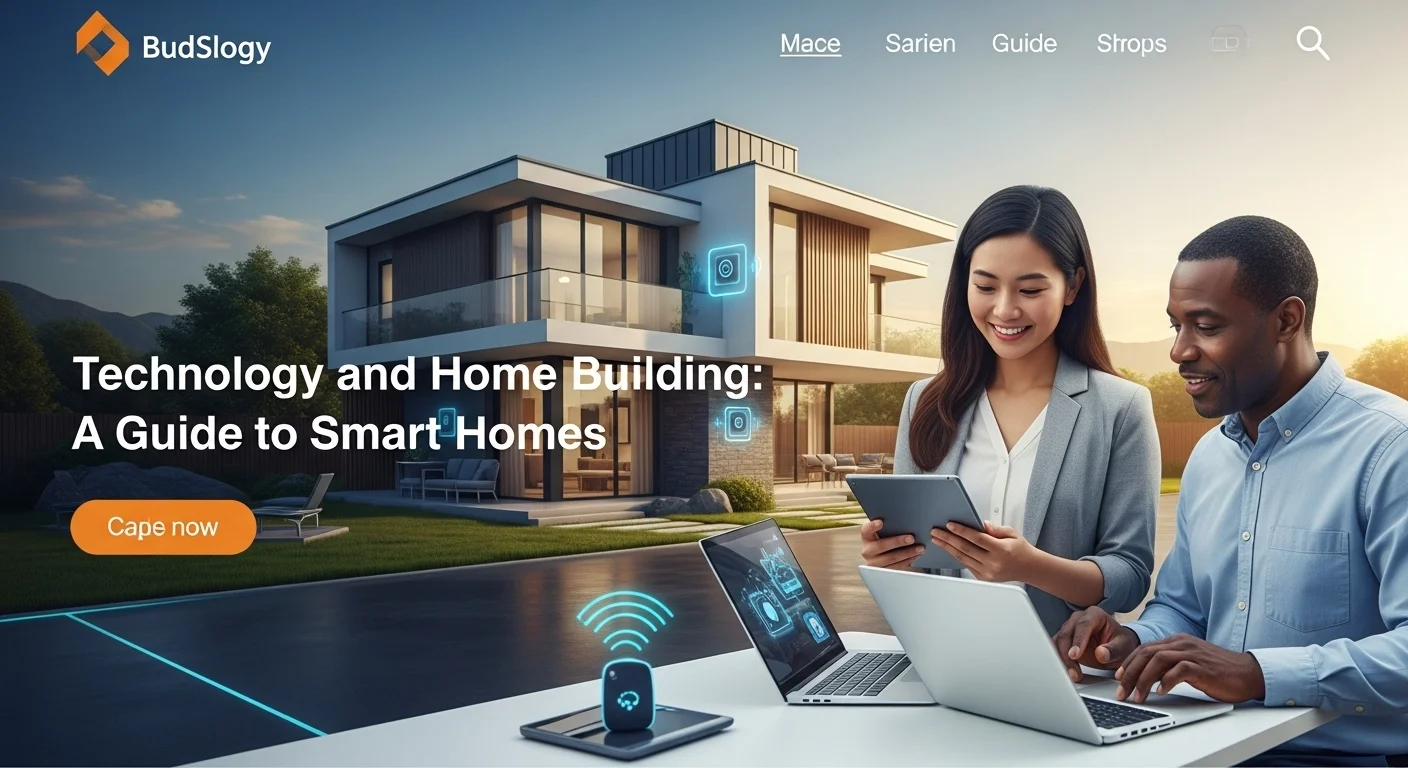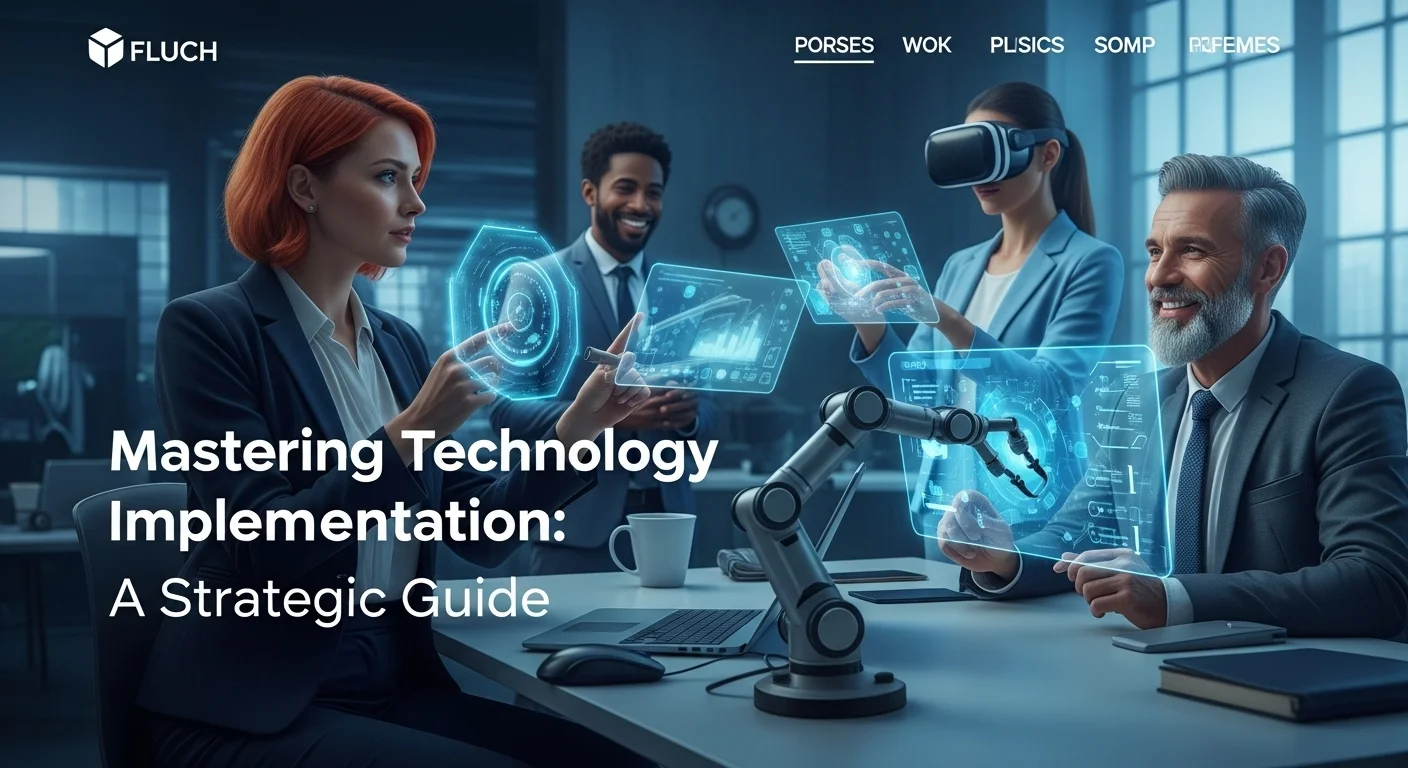Your Guide to Smart Home Technology in Modern Construction

Executive Summary
I've been in the home technology space for over a decade, and I can tell you, building a new home today is about so much more than just bricks and mortar. We're now creating living spaces that think, adapt, and genuinely make our lives easier. This is all thanks to the incredible fusion of construction with technology like Artificial Intelligence (AI), the Internet of Things (IoT), and advanced automation. For anyone in the business, from builders to tech lovers, this is a game-changing moment. Integrating a smart automation system is no longer a futuristic luxury; it's becoming a fundamental part of modern building. It's the key to unlocking better energy efficiency, iron-clad security, and a level of comfort we used to only dream about. In this article, I'll break down the tech, explore the business side of things, and share my hands-on experience to give you a complete guide to this exciting field. We'll get into the nuts and bolts, compare different approaches, and give you actionable advice for creating truly exceptional living spaces.
Table of Contents
Table of Contents
What is Smart Home Building and Why Does it Matter?
The world of home building used to be all about physical tools and paper blueprints. I remember those days well. But now, it’s undergoing a massive shift, powered by technology. Building a home today isn't just about putting up walls; it's about weaving an intelligent, connected environment right into the structure. This is where construction meets cutting-edge tech like AI and the IoT, completely redefining how we design, build, and actually live in our homes. This is so important because it helps us tackle big modern challenges like saving energy, boosting security, and simply making daily life more convenient. The real magic happens when this technology is integrated from the very beginning, making new homes inherently smarter and more efficient than older houses with a few smart gadgets added on.
At the heart of it all is what we call an integrated home automation system. Think of it as the central nervous system of your house. It's not just a collection of separate smart devices; it's a unified network that coordinates everything—lighting, climate, security cameras, locks, entertainment, and even your kitchen appliances. When you install this system during construction, you can hardwire it for ultimate reliability. I've seen firsthand how embedding dedicated cables and sleek in-wall touch panels into the home’s architecture creates a seamless experience. This foundational approach ensures all the pieces of the puzzle work together in harmony, which is something you just can't get from a bunch of separate, wireless products bought off the shelf.
This concept, often called home and building automation, scales up from a single house to large apartment buildings and commercial offices. The technology might get bigger, but the goal is always the same: create spaces that are more efficient, secure, and comfortable through smart control. For a homeowner, the benefits are huge. A smart system can learn your habits and optimize your heating and cooling to slash your utility bills. That's real money back in your pocket. On the security front, integrated cameras and smart locks offer incredible peace of mind, letting you check in on your home from anywhere. And for lifestyle, you can create 'scenes'—like a 'Movie Night' button that dims the lights, lowers the blinds, and turns on the TV. For those with accessibility needs, these systems are life-changing, providing easy control over their environment.
The Role of Smart Home Systems in Modern Construction
In my experience, builders and developers are quickly realizing that smart home systems are no longer an optional extra; they're a standard feature that buyers expect. A home that's pre-wired and ready for automation is just more valuable and better prepared for the future. This requires a shift in thinking, where architects, engineers, and tech specialists like me collaborate right from the design stage. We plan out where every sensor, controller, and wire should go. We use amazing tools like Building Information Modeling (BIM) software to create a 'digital twin' of the house. This 3D model includes not just the structure, but the entire automation layout, ensuring every component is perfectly placed for both performance and aesthetics.
Companies like ABB are true pioneers in the home & building automation field. They provide complete ecosystems, such as ABB-free@home® or the world-renowned KNX system, that act as the building's digital backbone. These systems are famous for being incredibly reliable and scalable, controlling everything from lights and blinds to heating and security. By working with established leaders like ABB, builders can offer their clients a proven, high-quality automation system that's both powerful and easy to use. This gives homebuyers confidence, knowing their smart home is built on a rock-solid and secure platform, which is absolutely critical for the systems that manage their daily life and safety.
Business Applications and Technological Synergy
This blend of tech and construction has opened up a world of new business opportunities. For builders, including smart home systems is a fantastic way to boost property value and stand out in the market. They can market homes as 'smart-ready' or offer different automation packages to fit various budgets. It's a strategy that attracts modern buyers and cements the builder's reputation as an innovator. It has also created a vital new profession: the smart home integrator. We're the specialists who bridge the gap between traditional construction and IT, designing and programming the complex networks that make a home smart.
The technologies fueling all this are AI, the IoT, and cloud computing. IoT devices—the sensors and smart appliances—are the system's eyes and ears. AI is the brain; it analyzes data to learn your preferences and make intelligent decisions for you. For example, an AI-powered system can learn your family’s routine and adjust the thermostat automatically, or notice an unusual pattern of activity and send you a security alert. The cloud is what connects it all, enabling remote access, data storage, and easy software updates. You can be on vacation and still see your security cameras, adjust the lights, or let a friend in through the front door, all from your phone. This powerful combination is what turns a house with gadgets into a truly intelligent home and building automation ecosystem. And believe me, this is just the beginning.

A Complete Guide to Smart Home Tech and Business Solutions
To successfully bring technology into home construction, you need a plan. It's not just about picking cool gadgets; it's about understanding the technical methods, business strategies, and resources out there. For any business looking to lead in this space, a holistic approach is key, from designing the system's architecture to educating the client. This guide is my roadmap for builders, developers, and tech integrators, based on years of in-the-field experience. It all starts with choosing the right technological foundation—a decision that will define the home's reliability, flexibility, and readiness for the future.
Technical Methods: Wired, Wireless, and Hybrid Systems
The communication network is the backbone of any home automation system. I always tell my clients to think of it like a highway system for your home's data. You have three main options.
1. Wired Systems: For new construction, a wired system is the gold standard. Period. This means running dedicated low-voltage cables from a central hub to every smart device—light switches, thermostats, touch screens, you name it. The biggest win here is rock-solid reliability and speed. Since it doesn't rely on Wi-Fi, it's immune to the signal drops and interference that can drive you crazy with wireless setups. For critical systems like security, you want this level of stability. It’s also more secure from a hacking perspective. The international KNX standard, which is the foundation for many ABB home and building automation solutions, is a perfect example of a powerful wired system. The only real downside is that it needs to be planned and installed during construction.
2. Wireless Systems: These systems use radio signals like Wi-Fi, Zigbee, or Z-Wave to connect devices. Their main appeal is the ease of installation. You can add them to an existing home without tearing up walls, which makes them great for renovations. You can start small and add more devices over time. However, I’ve troubleshooted enough wireless systems to know their weaknesses. They can be affected by interference from other devices or even dense building materials. Security is also a bigger concern; you need strong passwords and a secure network. The new Matter protocol is a promising step toward making different wireless brands play nice together, which has been a long-standing headache in the industry.
3. Hybrid Systems: In my opinion, a hybrid approach is often the most practical and intelligent solution for modern home & building automation. It gives you the best of both worlds. You use a wired backbone for the most critical systems—your network, security, and main lighting controls—and then use wireless devices for less essential or hard-to-reach spots. For instance, you might have a wired KNX system running the core of the house, but use a few wireless sensors to detect a water leak under a sink. This gives you bulletproof reliability where it counts, with the flexibility to expand easily. It’s a balanced strategy that optimizes both performance and cost.
Business Techniques for Successful Integration
If you're a builder, successfully selling a home automation system isn't just about the tech; it's about your business approach.
Consultation and Design: The process has to start with a real conversation. Don't just offer a standard package. Sit down with your clients and understand their lifestyle. Ask them: What's most important to you? Is it convenience, saving energy, or security? Are they tech-savvy or do they want something incredibly simple? Based on that, you can design a custom system. This consultative approach builds tremendous trust and ensures the client is happy in the long run. Partnering with a certified tech integrator is a great move here.
Tiered Packages and Selling the Experience: I've found that offering tiered packages works wonders. A 'Standard' package could cover the basics like smart lighting and a thermostat, plus pre-wiring for future upgrades. A 'Premium' package might add multi-room audio and motorized blinds. An 'Elite' package could be a full-blown ABB home and building automation system. The key is to sell the *benefit*, not the product. Don't say '10 smart switches.' Say, 'The ability to turn off every light in the house with one tap from your bed.'
Marketing and Showcasing: Seeing is believing. The single most effective way to sell home automation is to let people experience it. A model home with a fully functional smart system is your best marketing tool. People can touch the screens, talk to the voice assistant, and see how it all works together. It makes the benefits tangible. If you can't do a full model home, high-quality videos and virtual tours are the next best thing.
Available Resources and Comparisons
The market for home & building automation is huge, so knowing the key players is important.
Key Platforms and Manufacturers: At the high end, you have professional-grade systems from companies like Crestron, Savant, Control4, and ABB. These are my go-to for custom projects because they offer incredible performance and integrate with thousands of other devices. An ABB home and building automation system, for example, is built on the open KNX standard, which I love because it guarantees long-term compatibility. In the DIY or consumer space, you have platforms from Apple, Google, and Amazon. They're more affordable and accessible but don't offer the same deep integration or rock-solid reliability as a professional system. It's a classic trade-off: pro systems cost more but deliver superior performance, while consumer systems offer flexibility at a lower price point.

Tips and Strategies to Maximize Your Smart Home Experience
Getting technology into a new home is one thing; getting it *right* is another. It’s about more than just picking the latest hardware. It requires a smart strategy that focuses on the future, keeps your home secure, and puts the user experience first. For builders, it’s about adopting best practices. For homeowners, it's about making smart choices you won’t regret later. Here are my top tips for creating a home automation system that's secure, efficient, and genuinely improves your life.
Best Practices for Future-Proofing
Technology changes in the blink of an eye. To avoid having an outdated system in a few years, you have to future-proof your home. It’s not about predicting the future; it’s about building a foundation that can adapt to it.
1. When in Doubt, Run a Wire: This is my number one piece of advice. The single most important thing you can do to future-proof your home is to run more cable than you think you need. Wireless is great, but a structured wiring backbone is a permanent asset that adds real value. I always recommend running a 'combo' cable (with both Ethernet and coaxial) to any spot where you might one day want a TV, computer, or smart display. Even better, run plastic conduit through the walls to key locations. This gives you an easy path to pull new types of cable in the future without having to tear your walls open. Trust me, you'll thank yourself later.
2. Create a 'Tech Brain' Closet: Designate a dedicated, well-ventilated closet or utility space for all your central equipment. This is where your network router, switches, automation controllers, and media servers will live. Centralizing everything makes it so much easier to manage, troubleshoot, and upgrade components down the road. It also keeps all the heat and fan noise out of your living areas. Make sure this spot has plenty of power and cooling for future expansion.
3. Embrace Open Standards: Whenever you can, choose systems built on open, non-proprietary standards. The KNX protocol, used by ABB home and building automation and hundreds of other brands, is a fantastic example. Because KNX is a global standard, you're not locked into one company. You can mix and match devices from different manufacturers, knowing they'll all speak the same language. This saves you from the nightmare scenario where your whole system becomes obsolete because one company goes out of business. The new Matter standard is aiming to do the same for the wireless world, so it's a technology I'm watching closely.
Cybersecurity: Your Digital Front Door
As our homes get smarter, they also become new targets for cyber threats. I've seen the fallout from a compromised home automation system, and it can range from a serious privacy breach to a physical security risk. Securing your system isn't an option—it's an absolute necessity.
1. Lock Down Your Network: Your home network is the gateway to every smart device. Start by changing the default username and password on your router to something long and unique. Enable WPA3 encryption, the latest security standard. Here's a pro tip: create a separate, isolated Wi-Fi network just for your smart home devices. Most modern routers let you create a 'guest' network. By putting all your IoT gadgets on this separate network, you ensure that even if one device is compromised (like a cheap smart plug), the hacker can't get to your personal computers or smartphones.
2. Choose Secure Devices and Keep Them Updated: Go with manufacturers that take security seriously. Reputable companies like ABB invest heavily in securing their platforms. Always change the default passwords on every single device you install. Use two-factor authentication (2FA) wherever it's available, especially for apps controlling your security cameras or door locks. Finally, regularly check for and install firmware updates. These updates often contain critical security patches that protect you from the latest threats.
3. Professional and Physical Security: Don't forget to physically secure your gear. The equipment rack with your system's brain should be in a locked room or cabinet. From a business perspective, professional installation is a key part of the security puzzle. A certified integrator is trained to configure the system securely from the ground up and can teach the homeowner how to maintain that security.
Leveraging AI and Cloud Computing for a Smarter Home
The real magic of modern home & building automation is unlocked with Artificial Intelligence and cloud computing. These are the technologies that take a system from being just 'remote-controlled' to being truly 'smart'.
The Role of AI: Think of AI as the invisible assistant that learns your habits. It analyzes data from all the sensors in your home to automate things without you even having to ask. An AI-powered climate system doesn't just stick to a schedule; it learns how your house heats and cools, checks the weather forecast, and adjusts itself to be as energy-efficient as possible. In security, AI can tell the difference between a person, a car, and a cat, which means you get far fewer false alarms. As AI gets better, it will make our homes even more predictive and personalized.
The Power of the Cloud: The cloud provides a few key benefits for your home automation system. First, it's what allows you to check in and control your home from anywhere in the world with your smartphone. Second, it often does the heavy lifting for the AI, analyzing data to find patterns and send smart commands back to your home. Third, it makes software updates seamless, so your system is always running the latest and greatest features and security patches. When choosing a system, look at the manufacturer's cloud platform. Companies like ABB home and building automation have secure, robust cloud infrastructures designed to protect your data and privacy. For more information on industry best practices, I always point people to quality resources like the KNX Association, which champions secure and interoperable building control.
Expert Reviews & Testimonials
Sarah Johnson, Business Owner ⭐⭐⭐
The information on smart home construction is solid, but as a business owner, I would have loved to see a few more real-world case studies.
Mike Chen, IT Consultant ⭐⭐⭐⭐
A helpful article on integrating tech into home building. It gave me a much better grasp of the subject, though a couple of the technical concepts could have been simplified a little more.
Emma Davis, Tech Expert ⭐⭐⭐⭐⭐
Fantastic article! It's a really comprehensive look at smart home building. This was incredibly helpful for my specialization, and I found it all perfectly clear.



